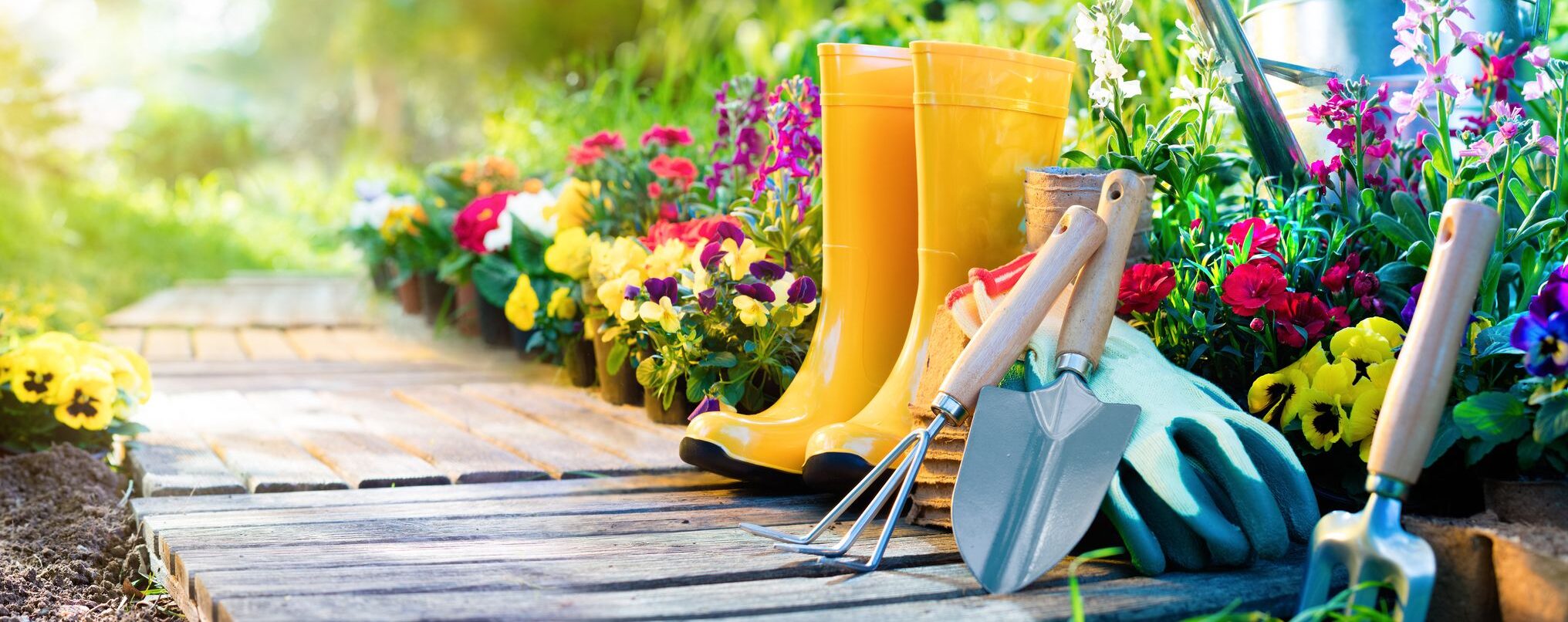
Creating a water garden for your home
Water gardens are beautiful features for around your property. With the availability of labour saving techniques and materials, creating an attractive water garden can be accomplished with relative ease. There is no better time to incorporate a water feature into your home’s outdoor’s. We can help you choose the right products when it comes to water garden installation. We have alot of knowledge on varieties of pond products and aquatic pants and the best places in Nanaimo, BC to get them
What is the best location for a water garden?
Choose a sunny site; minimum 5 hours/day.
Avoid placing water gardens under trees because falling debris can clog pumps or filter systems and accumulate on the bottom causing discolored water.
Flat or slightly elevated areas are best for your pond. Low-lying areas should be avoided as run-off from the rest of the garden could be problematic.
You will need to run electricity to the site. A ground fault circuit interrupter should be used.
Choose a site that is visible, so you can enjoy your pond.
Flexible Liners
- It can be used to make any shape or size of pond you want
- It is less expensive then pre-formed.
- It can be installed with ease.
- It can be purchased in 10 foot, 15 foot, and 20 foot widths.
- Calculating the amount of liner required:
Length of liner: Maximum length + (depth x 2) + 2 feet (overlap)
Width of Liner: Maximum width + (depth x 2) + 2 feet (overlap)
Pre-formed Liners:
- Come in various shapes and sizes.
- Are slightly more expensive then flexible liners.
- Are easy to install
How to choose a water garden pump
Your pump should circulate the entire volume of your pond once every two hours.
Calculating pond volume, all measurement taken in feet:
Length (feet) X Width (feet) X Depth (feet) X 7.5 = # of gallons
Use a separate pump for each feature
One pump for circulation.
One pump for a spitter.
One pump for a fountain.
Plant leaves should cover two thirds of the water’s surface.
A Ground Fault Circuit Interrupter should be used. This will interrupt the electricity if the cord is accidentally cut or frayed.

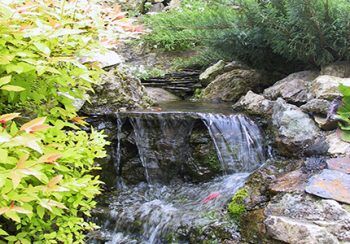
How to maintain your water garden
Maintaining your pond is essential for creating an environment friendly for fish and plants. A pond and its inhabitants go through seasonal cycles. Maintenance tasks vary slightly from season to season.
SPRING
Remove any dead foliage and clean up any debris that has collected over the winter.
After the last frost, divide, replant and fertilize plants and water lilies.
After the last frost add new plants to the pond, minimum water temperature 15 °C (60°F)
Fish will start to come out of dormancy, start feeding them.
Inspect pumps, filters and accessories, and clean if necessary. Put them in the pond and start running them.
If you have excess algae, this is normal. As plants start to grow the problem will correct itself.
SUMMER
Aquatic plants are growing and flowering. Keep the plants maintained – dead-head, remove discolored leaves, and watch for pests and diseases.
As temperatures increase, water evaporation also increases. Be sure to check the water levels regularly and top up pond.
Check fish periodically so you can catch and treat any sick fish immediately.
Clean the filter pads regularly to maintain water clarity.
Check the pumps to make sure they are functioning properly.
FALL
Remove any fallen leaves and debris from the pond.
Clean the pump and filter regularly.
As plants begin to turn brown, trim them back.
Move tropical and frost tender plants indoors.
You can empty the pond, put plants in cold storage, and bring the fish indoors.
WINTER
Fish become inactive and go dormant.
Remove the pump and clean it.
Remove filters – drain and rinse, allow drying, and place them in storage.
Aquatic Plants
Aquatic plants are essential to a pond’s ecosystem. Finding the right combination of plants will help with water clarity, deter algae bloom, and provide aesthetics. There are five different groups of water plants: marginal, submerged plants, floaters, oxygenators, and water lilies. When choosing plants a general guideline to keep in mind is two-thirds of the water surface should be covered by plant material.
MARGINALS – this is the largest group of aquatic plants that have roots growing in soil and leaves that float on the surface or stand upright above it. They prefer to be located in shallow water so they are ideal for plant shelves, pedestals, or boggy areas around the edge of the pond. They prefer a depth of 0-6 inches (0-15cm) of water above the crown (top of the pot). The roots of these plants absorb algae causing nutrients from the water while the tops add colour, height, texture, and flowering to the ponds edge.
Here are a few example of hardy marginal;
Arrowhead, Cattails, Marsh Marigold, Iris, Pickerel Weed, and Lizard’s Tail.
Here are a few examples of tropical marginal:
Umbrella Plant, Parrots Feather, Hardy Banana, Elephant Ears, and Canna Lilies.
Submerged Plants –
All ponds should have some of these plants. They help maintain clean water by deterring algae growth; they use excess nitrogen and put oxygen into the water. These plants are completely submerged in water; the pots sit at a depth of at least 12 inches (30cm).
Floating plants –
these plants don’t have to be planted in soil, they are free floating so all you have to do is place them in the water and they will grow. Floaters have two important functions; The roots absorb minerals from the water, which helps out – compete green water algae, and the leaves offer shade and cover for the fish below. You will need 3 plants per 10 square feet. They are considered tropical, so they cannot tolerate frost and are best treated as annuals.
Here are some examples of floaters: Water hyacinth, water lettuce, frog bit, and fairy moss.
Oxygenators –
are natural pond filters. They produce and release oxygen into the water and compete with green water algae for available food. They help balance the pond and maintain water clarity. Parrot’s Feather and Mare’s tail are two great oxygenators.
Water Lilies –
are one of the most popular feature plants for water gardens. They not only provide exotic foliage and flowers but they also provide much needed shade and refuge. Hardy water lilies bloom from June through September and come in pink, purple, orange, red, yellow, and white. These lilies require a site that receives 5 hours of sun per day and they prefer calm, still water away from splashing waterfalls and fountains. Water lilies can be left in the pond year round, provided it is at least 1.2m deep, or taken indoors for the winter.
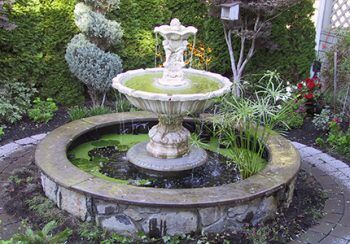
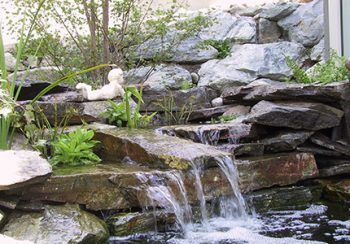
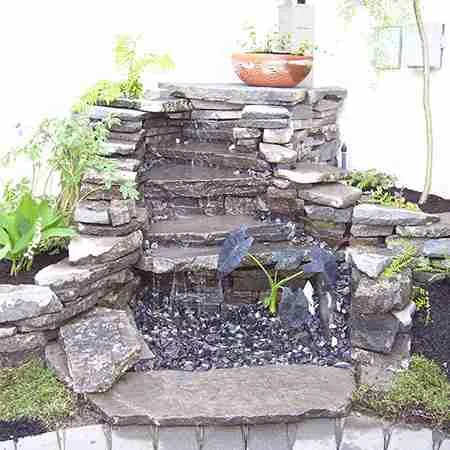
Water garden plant care:
Exposure –
most aquatics require direct sun to grow well. When choosing a site for your pond, keep this in mind.
Planting –
Fill containers with a heavy clay based garden soil or a special aquatic plant soil. The soil should not contain any chemicals or fertilizers. After placing the plant in the container, pack the soil tightly around the roots leaving 1-2inches (2-5cm) of space below the container’s rim. Cover the surface of the soil with 1-2 inches (2-5cm) of pea gravel or sand to keep the soil from floating up.
Fertilizing –
Use specially formulated tabs that release nutrients slowly over the course of the season.
Use fertilizer pond spikes. These spikes are pushed into the soil and slowly release nutrients over the course of a season.
Floating plants are fertilized with liquid or water soluble fertilizers.
** Over fertilizing can cause an abundance of algae growth**
Over wintering plants in your water garden
Hardy plants can be healed into the ground. Plant pot and plant into the ground.
Tropical plants can be brought indoors for the winter.
Floating plants are best treated as annuals.

